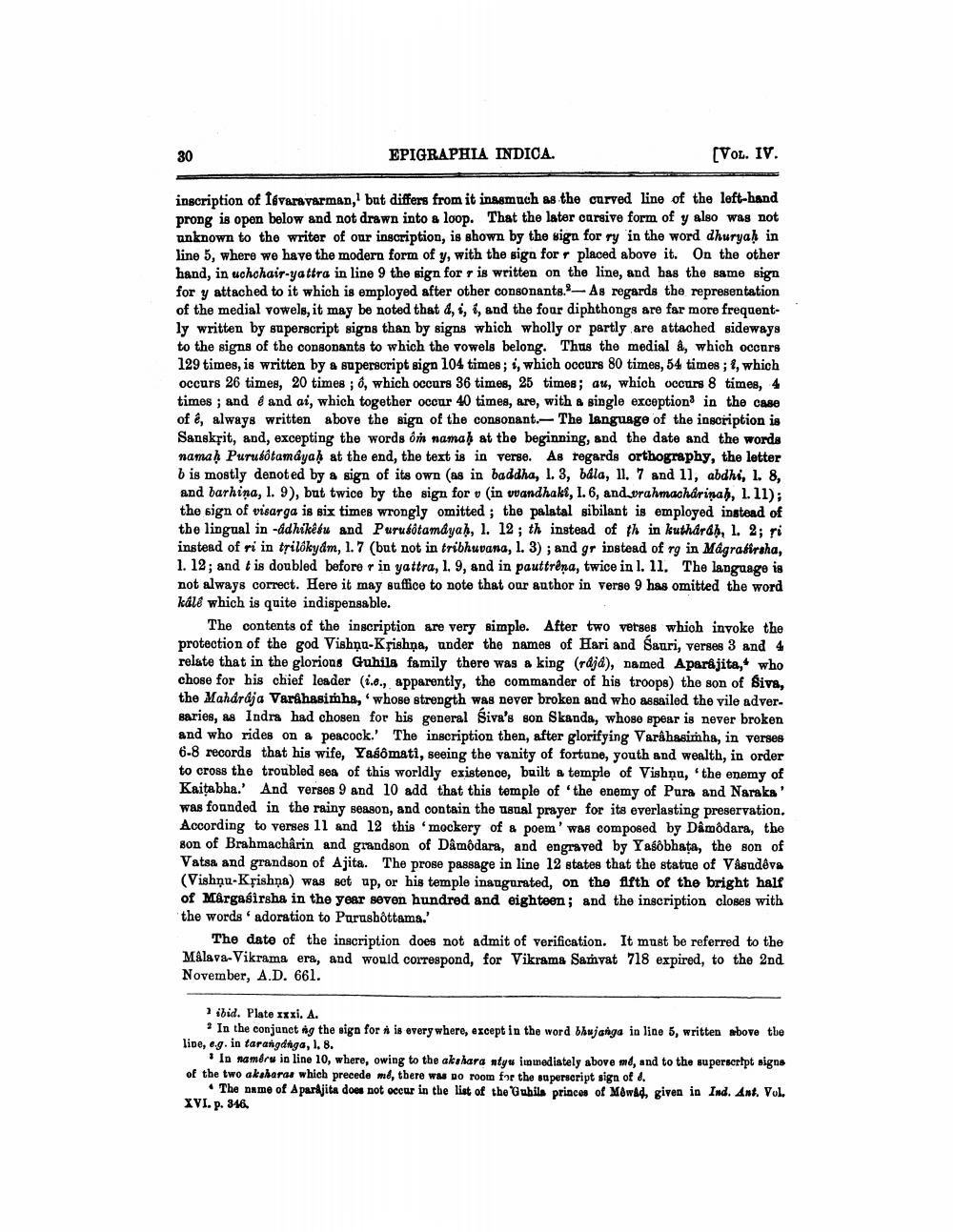________________
30
EPIGRAPHIA INDICA.
[VOL. IV.
inscription of Iévaravarman,' but differs from it inasmuch as the curved line of the left-hand prong is open below and not drawn into a loop. That the later cursive form of y also was not unknown to the writer of our inscription, is shown by the sign for ry in the word dhuryaḥ in line 5, where we have the modern form of y, with the sign for placed above it. On the other hand, in uchchair-yattra in line 9 the sign for r is written on the line, and has the same sign for y attached to it which is employed after other consonants. As regards the representation of the medial vowels, it may be noted that a, i, i, and the four diphthongs are far more frequently written by superscript signs than by signs which wholly or partly are attached sideways to the signs of the consonants to which the vowels belong. Thus the medial â, which occurs 129 times, is written by a superscript sign 104 times; i, which occurs 80 times, 54 times; ?, which occurs 26 times, 20 times; ô, which occurs 36 times, 25 times; au, which occurs 8 times, 4 times; and é and ai, which together occur 40 times, are, with a single exception in the case of ê, always written above the sign of the consonant.- The language of the inscription is Sanskrit, and, excepting the words om namah at the beginning, and the date and the words namaḥ Purusotamayaḥ at the end, the text is in verse. As regards orthography, the letter b is mostly denoted by a sign of its own (as in baddha, 1. 3, bála, 11. 7 and 11, abdhi, 1. 8, and barhina, 1. 9), but twice by the sign for v (in vvandhake, 1.6, and vrahmacharinah, 1.11); the sign of visarga is six times wrongly omitted; the palatal sibilant is employed instead of the lingual in -adhikêsu and Purusotamayaḥ, 1. 12; th instead of th in kuthardḥ, 1. 2; ri instead of ri in trilokyám, 1.7 (but not in tribhuvana, 1. 3); and gr instead of rg in Mâgrasirsha, 1. 12; and t is doubled before r in yattra, 1. 9, and in pauttrêna, twice in 1. 11. The language is not always correct. Here it may suffice to note that our author in verse 9 has omitted the word kálé which is quite indispensable.
The contents of the inscription are very simple. After two verses which invoke the protection of the god Vishnu-Krishna, under the names of Hari and Sauri, verses 3 and 4 relate that in the glorious Guhila family there was a king (rajd), named Aparajita, who chose for his chief leader (i.e., apparently, the commander of his troops) the son of Siva, the Mahdrája Varahasimha, whose strength was never broken and who assailed the vile adversaries, as Indra had chosen for his general Siva's son Skanda, whose spear is never broken and who rides on a peacock.' The inscription then, after glorifying Varâhasimha, in verses 6-8 records that his wife, Yasômati, seeing the vanity of fortune, youth and wealth, in order to cross the troubled sea of this worldly existence, built a temple of Vishnu, 'the enemy of Kaiṭabha.' And verses 9 and 10 add that this temple of the enemy of Pura and Naraka' was founded in the rainy season, and contain the usual prayer for its everlasting preservation. According to verses 11 and 12 this 'mockery of a poem' was composed by Dâmôdara, the son of Brahmacharin and grandson of Dâmôdara, and engraved by Yasôbhata, the son of Vatsa and grandson of Ajita. The prose passage in line 12 states that the statue of Vasudeva (Vishnu-Krishna) was set up, or his temple inaugurated, on the fifth of the bright half of Margasirsha in the year seven hundred and eighteen; and the inscription closes with the words adoration to Purushottama.'
The date of the inscription does not admit of verification. It must be referred to the Malava-Vikrama era, and would correspond, for Vikrama Samvat 718 expired, to the 2nd November, A.D. 661.
1 ibid. Plate xxxi. A.
In the conjunct g the sign for ǹ is every where, except in the word bhujanga in line 5, written above the line, eg. in tarangdiga, 1. 8.
In naméra in line 10, where, owing to the akshara ntyu immediately above me, and to the superscript signs of the two aksharas which precede mé, there was no room for the superscript sign of 4.
The name of Aparajita does not occur in the list of the Guhila princes of Mowad, given in Ind. Ant. Vol. XVI. p. 346.




